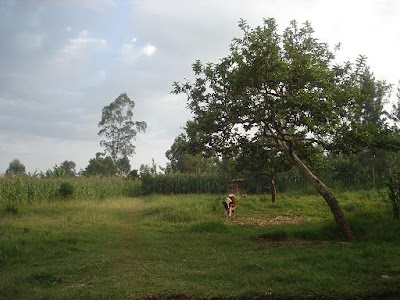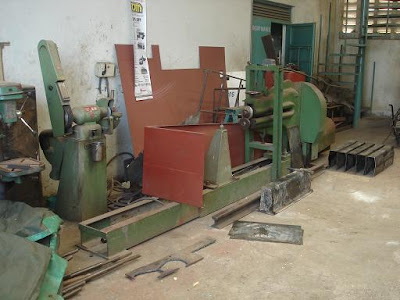Thursday, July 23, 2009
New Faces
Nairobi's Informal Sector
On Thursday we went to the industrial area (Gikomba) to learn more about informal industry and fabrication. I had been there once before with Clarice, before Steve arrived, but we just drove through so that I could see the kinds of things that they were making. This time, Clarice made friends with some Luos who were fabricating aluminum trunks on the side of the road. We got out of the car and Clarice talked to them for a few minutes, asking some questions about how they made the trunks. They showed us the raw materials, how they used chisels and shears to cut the metal, and how they made the handles and joined the corners. Basically they made the entire trunk out of aluminum sheets, a few rivets, and some metal rods. They used hammers, shears, and a chisel. And they had an I-beam that they used as a surface to hammer on. It was great for bending the metal rods. The hammer that they use has a hollow metal handle. To put the rivets in, they put the rivet under the two sheets of metal they are joining, then hit the hollow end of the handle down hard on top the sheets so that the rivet pokes through. Then they hammer down the now exposed end of the rivet. They are very skilled and able to work quickly. One of the guys made a trunk handle in about 30 seconds. They also showed us how they joined the corners. The top of each side has a lip on it, so they bend a metal rod and put one end in one side of the box and the other in the side they are joining it to. Then they fold over the flat metal part.
Once we made friends with these guys, they agreed to show us around the area and take us to some of the places where they bought materials and they showed us almost everything that was made in the area and how it was made. We saw so many creative ideas. Necessity breeds innovation. They were recycling all kinds of products, especially metal cans, which they turned into kerosene lamps and piggy banks. They made all kinds of bowls and pots. For these, they took a round sheet of metal, held it over a metal ring with their feet, and pounded the middle in with a HUGE sledgehammer to form the bowl shape. It was amazing to see all of the men working simultaneously. There were about 50 of them, so the noise was deafening. But they were all incredibly strong. People were working so hard. And all just to live on about $1 a day.
One of my favorite things was the machine that they had come up with to heat up a fire for blacksmithing. It had a hand crank that you turn which turns a fan that blows air into a very large underground sort of tunnel and that air gets blown onto the coals, causing the fire to heat up very quickly. The machine was man-powered and local made, but very effective. Each time we saw new tools or products, I was just in awe of what they could make out of so little. It’s all about minimizing material use. Some other cool things we saw were a grill with a really cool mechanism for raising and lowering the grate and a hand-powered threshing machine…sound familiar? It was small, transportable, and simply designed.
I was also impressed at how few tools they used. They had some local-built machines for cutting metal and punching holes, but other than that all we saw were hammers, saws, chisels, and shears. There was some welding equipment, but only very basic, there was soldering (of course no soldering irons), and we even saw one power drill. There was also a metallic sort of paste that was used to join metal. When it dried, it was as hard as the aluminum.
Sunday, July 19, 2009
Return to Nairobi
Saturday, July 18, 2009
Molasses Plant
Visit with Laban
 Demo stove and raw materials - sawdust and anthill dirt. Anthills are huge in Kenya, meaning several feet tall, no joke.
Demo stove and raw materials - sawdust and anthill dirt. Anthills are huge in Kenya, meaning several feet tall, no joke. His farm, a typical rural homestead
His farm, a typical rural homestead The family's water source. Luckily, they purify it with moringa powder before drinking it. Moringa powder is a natural coagulant and causes the bacteria to float to the bottom. Many families drink similar water without purification.
The family's water source. Luckily, they purify it with moringa powder before drinking it. Moringa powder is a natural coagulant and causes the bacteria to float to the bottom. Many families drink similar water without purification. Part of Laban's family - too cute
Part of Laban's family - too cute Moringa tree on a neighboring homestead. The leaves are very nutritious, as are the pods. The seeds, which are inside the pods, can be dried and ground into powder, which can be added to food, used to make tea, or used to purify water. The tree also has antibiotic properties and makes a great animal feed. Not surprisingly, the tree is nicknamed the miracle tree.
Moringa tree on a neighboring homestead. The leaves are very nutritious, as are the pods. The seeds, which are inside the pods, can be dried and ground into powder, which can be added to food, used to make tea, or used to purify water. The tree also has antibiotic properties and makes a great animal feed. Not surprisingly, the tree is nicknamed the miracle tree.

















































